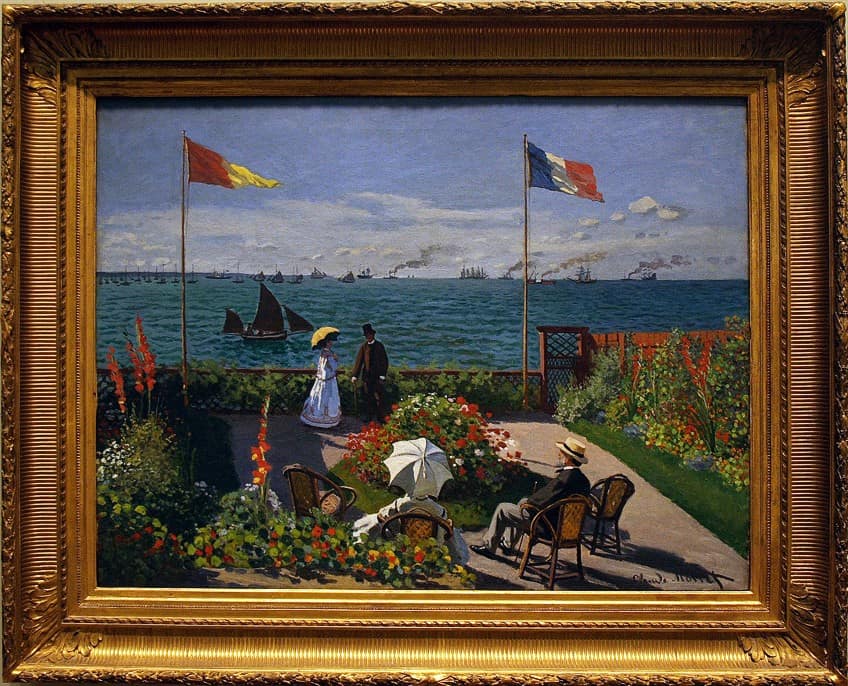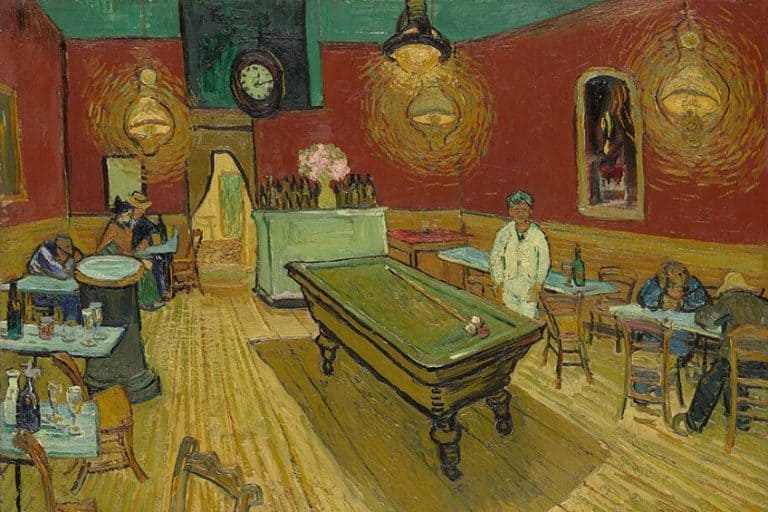“Garden at Sainte-Adresse” by Claude Monet – The Masterpiece
Garden at Sainte-Adresse by Claude Monet is a captivating portrayal of coastal living. Painted in 1867, it showcases Monet’s mastery of capturing nature’s essence with light and color. Against the Normandy coast, the painting blends lush foliage, vibrant blooms, and the sea’s expanse in a harmonious symphony. Through nuanced brushwork, Monet creates a tranquil oasis where land, sea, and sky merge. In this analysis, we explore how Monet’s innovative Impressionist approach revolutionized art history.
Table of Contents
Key Takeaways
- The Garden at Sainte-Adresse is a significant work by Claude Monet from his early career.
- Monet’s painting illuminates his penchant for capturing light and the experience of leisure.
- The artwork is an exemplar of Impressionist technique and resides at the Metropolitan Museum of Art.
Historical Context
| Artist | Claude Monet (1840 – 1926) |
| Date Created | 1867 |
| Medium | Oil on canvas |
| Genre | Impressionism |
| Period/Movement | Impressionism |
| Dimensions (cm) | 98.1 x 129.9 |
| Series/Versions | N/A |
| Where Is It Housed? | The Metropolitan Museum of Art, New York City, United States |
| What It Is Worth | Estimated to be invaluable, in terms of artistic and cultural significance. |
The Garden at Sainte-Adresse is a vibrant painting by the French Impressionist painter Claude Monet. Completed in 1867, this celebrated work of art reflects a personal and evocative scene painted by Monet during a period of leisure at Sainte-Adresse, near Le Havre, France.
The canvas captures the essence of a seaside garden, portraying Monet’s family against a backdrop that blends domestic tranquility with the dynamic nature of the maritime landscape.
Monet’s piece conveys not only the relaxed atmosphere of a holiday retreat but also showcases the Impressionist’s skill in capturing the effects of light, with a composition that balances areas of detailed rendering and brisk brushwork. Owned by the Metropolitan Museum of Art since its acquisition in 1967, the painting stands as a testament to Monet’s early exploration of open-air painting, which would come to define his life’s work.
Monet and the Summer of 1867
Claude Monet, the famed French Impressionist painter, spent the summer of 1867 in Sainte-Adresse, a trendy resort town near Le Havre. It was during this period that Monet captured the luminous coastal environment on canvas. Garden at Sainte-Adresse is a vivid testament to his summer experiences, using his family as models and expressing the leisurely lifestyle of the era through art.

Impressionist Movement Origins
The Impressionist movement, although not officially branded as such during the painting’s creation, was beginning to take shape. Originating in France, the movement sought to capture the momentary effects of light and color, which Monet adeptly showcases in this work. Garden at Sainte-Adresse exhibits characteristics that would later define Impressionism, such as the juxtaposition of vivid colors and the depiction of contemporary life through a candid perspective.
Monet’s painting is a harbinger of the transforming art scene in 19th-century France.
Formal Analysis
The formal elements of Claude Monet’s Garden at Sainte-Adresse present a captivating interplay of vibrant color, deft composition, and innovative brushwork. These aspects come together to shape a cohesive and pioneering Impressionist work.

Subject Matter
The painting captures a familial scene set in a flower-bordered terrace overlooking the sea, conveying leisure and tranquility. The figures are posed casually, anchoring the viewer’s attention amidst the profuse display of nature and the distant horizon. Claude Monet often used friends, family members, and sometimes himself as models in his paintings, particularly in his earlier works.
However, in Garden at Sainte-Adresse, Monet did not depict specific individuals.
Instead, the painting primarily focuses on the landscape and the atmosphere of the coastal garden at Sainte-Adresse. While Monet’s later works often included figures, Garden at Sainte-Adresse primarily emphasizes the beauty of nature and the interplay of light and color in the outdoor setting, rather than specific human subjects.
Use of Color and Light
Monet’s palette is rich with juxtapositions of hue that articulate the forms and depths of the scene. Light is a defining feature, exemplified by the play of sunshine on surfaces and the luminous sky overhead. The treatment of light anticipates the modulation of pure color, indicative of Impressionism.

Composition and Technique
Garden at Sainte-Adresse boasts a balanced composition with a clear division between the domestic garden in the foreground and the expansive view of the sea in the background. Monet uses flattened spaces, possibly influenced by Japanese prints, akin to those of Hokusai, amalgamating Western and Eastern pictorial traditions.
The horizon serves as the pivotal axis, demarcating the terrestrial from the marine.
Comparison to Contemporary Works
Adjacent to 19th-century European paintings that emphasized narrative and detail, Monet’s work diverges through its brushwork—quick, separate strokes that coalesce into a cohesive image when viewed at a distance. The painting stands out for its innovative approach, paralleling contemporary trends in Chinese and Japanese painting, which prized suggestion over explicit portrayal.

Symbolism and Themes
In Garden at Sainte-Adresse, Claude Monet captures the essence of 19th-century leisure and familial bonds while also displaying the early influence of Japanese art on his work. The painting, rich in symbolism, reflects a period of transformation in Monet’s artistic style.
Representation of Leisure and Family
Garden at Sainte-Adresse offers an intimate glimpse into Monet’s personal life through its depiction of figures believed to be his family. The scene is set upon a terrace, a symbol of private, cultivated nature, and a space for relaxation.
Monet’s father, Adolphe, is depicted seated, representing the patriarch’s protective presence over the family unit.
Meanwhile, the artist’s aunt, Sophie, stands as an embodiment of the nurturing, matriarchal figure. The presence of these figures, along with Monet’s cousin’s wife who is also featured in the painting, illustrates the theme of family solidarity.
Influence of Japanese Art
Monet’s exposure to Japanese prints is reflected in the composition’s organization. The use of Japanese color woodblock prints can be drawn back to its methodical layering and flat color application, evoking the structure of Japanese prints through the delineation of the garden, terrace, and sea.

Moreover, the painting foreshadows Monet’s future residence in Giverny, where he would integrate a Japanese-inspired water garden, reinforcing the notion that Japanese aesthetics played a pivotal role in Monet’s work. This clear inspiration has provided commentators and art historians with evidence of the early integration of Japanese themes within Impressionist art.
The Artwork Today
Garden at Sainte-Adresse is a celebrated painting by Claude Monet, currently on display at the Met Fifth Avenue in Gallery 818. Painted in 1867, the artwork is acknowledged for its historical significance in the French Impressionist movement. Visitors have the opportunity to view this masterpiece, which presents a vibrant seaside scene representative of Monet’s early experimentation with light and color.
Since its acquisition by the Metropolitan Museum of Art after a Christie’s auction in December 1967, the painting has been a highlight of the museum’s European Paintings collection.
The artwork measures at 98.1 x 129.9 centimeters, an imposing oil on canvas that commands attention. Visitors’ experiences are enriched by the context provided by the Met, shedding light on the painting’s composition and its setting in Sainte-Adresse, a resort near Le Havre. The vivid brushwork and use of light convey the leisurely atmosphere of a summer by the seaside, an inviting scene Monet witnessed when he spent the summer there with his family.

As of the current date, no traveling exhibitions involving the painting have been announced. Art enthusiasts, historians, and the general public can marvel at this piece at its permanent home at the Met, ensuring its continued appreciation by future generations.
Garden at Sainte-Adresse epitomizes Claude Monet’s mastery of capturing nature’s beauty through Impressionism. Through skillful brushwork and a harmonious blend of light and color, Monet transports viewers to a world where land, sea, and sky converge. This masterpiece not only celebrates coastal living but also showcases Monet’s enduring influence on art history, inspiring generations with its timeless beauty and serene allure.
Frequently Asked Questions
What Is the Historical Context of Monet’s Garden at Sainte-Adresse?
The Garden at Sainte-Adresse was painted by Claude Monet in 1867. He spent the summer of that year in the resort town of Sainte-Adresse, near Le Havre in Normandy. This period coincided with Monet’s early artistic development when he was experimenting with outdoor light effects that would later become central to Impressionism.
What Inspired Monet to Paint Garden at Sainte-Adresse?
Monet was inspired by his immediate surroundings and the bourgeoise leisure of the coastal resort. The painting captures a garden overlooking the sea, likely influenced by Monet’s desire to document the changing qualities of light and the serene ambiance of the seaside setting. Scenes of leisure, water, and floral landscapes were among his favorite subjects during this phase of his career.
Isabella studied at the University of Cape Town in South Africa and graduated with a Bachelor of Arts majoring in English Literature & Language and Psychology. Throughout her undergraduate years, she took Art History as an additional subject and absolutely loved it. Building on from her art history knowledge that began in high school, art has always been a particular area of fascination for her. From learning about artworks previously unknown to her, or sharpening her existing understanding of specific works, the ability to continue learning within this interesting sphere excites her greatly.
Her focal points of interest in art history encompass profiling specific artists and art movements, as it is these areas where she is able to really dig deep into the rich narrative of the art world. Additionally, she particularly enjoys exploring the different artistic styles of the 20th century, as well as the important impact that female artists have had on the development of art history.
Learn more about Isabella Meyer and the Art in Context Team.
Cite this Article
Isabella, Meyer, ““Garden at Sainte-Adresse” by Claude Monet – The Masterpiece.” Art in Context. February 18, 2024. URL: https://artincontext.org/garden-at-sainte-adresse-by-claude-monet/
Meyer, I. (2024, 18 February). “Garden at Sainte-Adresse” by Claude Monet – The Masterpiece. Art in Context. https://artincontext.org/garden-at-sainte-adresse-by-claude-monet/
Meyer, Isabella. ““Garden at Sainte-Adresse” by Claude Monet – The Masterpiece.” Art in Context, February 18, 2024. https://artincontext.org/garden-at-sainte-adresse-by-claude-monet/.











